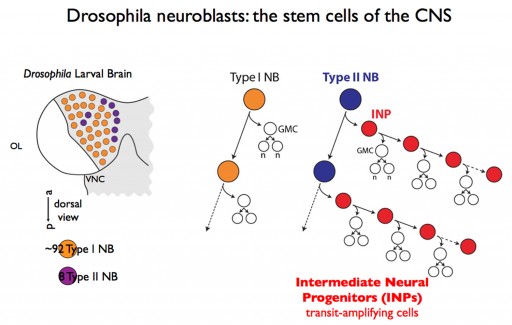How neural stem cells create new and varied neurons
June 21, 2013
A new study examining the brains of fruit flies reveals a novel stem cell mechanism that may help explain how neurons form in humans.
“The question we confronted was ‘How does a single kind of stem cell, like a neural stem cell, make all different kinds of neurons?,'” said Chris Doe, a biology professor.
Researchers have known for some time that stem cells are capable of producing new cells, but the new study shows how a select group of stem cells can create progenitors that then generate numerous subtypes of cells.
“Instead of just making 100 copies of the same neuron to expand the pool, these progenitors make a whole bunch of different neurons in a particular way, a sequence,” Doe said. “Not only are you bulking up the numbers but you’re creating more neural diversity.”
The study, builds on previous research from the Doe Lab published in 2008. That study identified a special set of stem cells that generated neural progenitors. These “intermediate neural progenitors” (INPs) were shown to blow up into dozens of new cells. The research accounted for the number of cells generated, but did not explain the diversity of new cells.
Neuroblasts + INP patterning -> increased neural diversity
For their new study, Bayraktar and Doe zeroed in on the stem cells in drosophila (fruit flies) known as type II neuroblasts. The neuroblasts, which had previously been shown to generate INPs, were shown in this study to be responsible for a more complex patterning of cells.
The INPs were shown to sequentially generate distinct neural subtypes. The research accounted for additional neural diversity by revealing a second axis in the mechanism. Instead of making 100 neurons, as had been previously thought, a stem cell may be responsible for generating some 400 or 500 neurons.
The study concludes that neuroblasts and INP patterning act together to generate increased neural diversity within the central complex of the fruit fly and that progenitors in the human cerebral cortex may use similar mechanisms to increase neural diversity in the human brain. One long-term application of the research may be to eventually pinpoint stem cell treatments to target specific diseases and disorders.
“If human biologists understand how the different types of neurons are made, if we can tell them ‘this is the pathway by which x, y and z neurons are made,’ then they may be able to reprogram and redirect stem cells to make these precise neurons,” Doe said.
The mechanism described in the paper has its limits. Eventually the process of generating new cells stops. One of the next questions to answer will be what makes the mechanism turn off, Doe said.
The study was funded by the Howard Hughes Medical Institute and the NIH National Institute of Child Health and Human Development.
